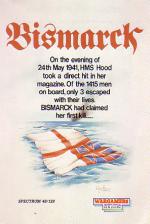Other Reviews Of Bismarck For The Spectrum 48K
Bismarck (PSS)
A review by Philippa Irving (Crash)
Bismarck (PSS)
A review by Peter Berlin (Your Sinclair)
Bismarck (Summit)
A review by Garth Sumpter (Sinclair User)
Bismarck (PSS)
A review
Bismarck (PSS)
A review


 27th March 1987
27th March 1987











